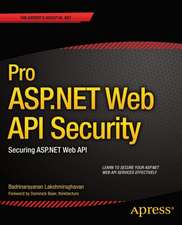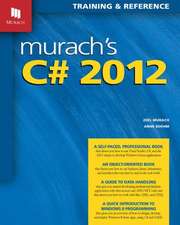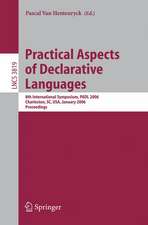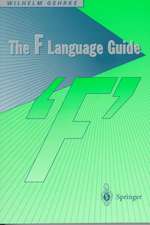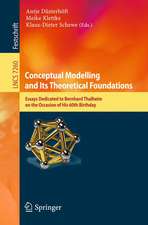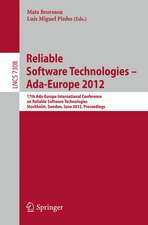Fortran 90 Language Guide
Editat de Wilhelm Gehrkeen Limba Engleză Paperback – 13 apr 1995
Preț: 338.81 lei
Preț vechi: 423.52 lei
-20% Nou
Puncte Express: 508
Preț estimativ în valută:
64.84€ • 67.44$ • 53.53£
64.84€ • 67.44$ • 53.53£
Carte tipărită la comandă
Livrare economică 14-28 aprilie
Preluare comenzi: 021 569.72.76
Specificații
ISBN-13: 9783540199267
ISBN-10: 3540199268
Pagini: 392
Ilustrații: XVI, 385 p.
Dimensiuni: 155 x 235 x 27 mm
Greutate: 0.59 kg
Ediția:1st ed. 1995. 2nd printing2nd Printing.
Editura: SPRINGER LONDON
Colecția Springer
Locul publicării:London, United Kingdom
ISBN-10: 3540199268
Pagini: 392
Ilustrații: XVI, 385 p.
Dimensiuni: 155 x 235 x 27 mm
Greutate: 0.59 kg
Ediția:1st ed. 1995. 2nd printing2nd Printing.
Editura: SPRINGER LONDON
Colecția Springer
Locul publicării:London, United Kingdom
Public țintă
Professional/practitionerCuprins
1 Source form.- 1.1 Fixed Source Form.- 1.2 Free Source Form.- 1.3 Embedding of Program Lines by INCLUDE.- 1.4 Classification of Fortran Statements.- 1.5 Statement Ordering.- 2 Type Concept.- 2.1 Intrinsic Types.- 2.2 Derived Types.- 3 Lexical Tokens.- 3.1 Scoping Units.- 3.2 Keywords.- 3.3 Names.- 3.4 Operators.- 3.5 Statement Labels.- 3.6 Literal Constants.- 4 Data Objects.- 4.1 Constants.- 4.2 Variables.- 4.3 Sealars.- 4.4 Arrays.- 4.5 Structure Components.- 4.6 Automatic Variables.- 4.7 Association.- 4.8 Definition Status.- 5 Pointers.- 5.1 Pointer Processing.- 6 Array Processing.- 6.1 Array Declaration.- 6.2 Reference and Use.- 6.3 Memory Management and Dynamic Control.- 6.4 Construction of Array Values.- 6.5 Operations on Arrays.- 7 Expressions.- 7.1 Numeric Intrinsic Expressions.- 7.2 Relational Intrinsic Expressions.- 7.3 Logical Intrinsic Expressions.- 7.4 Character Intrinsic Expressions.- 7.5 Defined Expressions.- 7.6 Common Rules for Expressions.- 7.7 Special Expressions.- 8 Assignments.- 8.1 ASSIGN Statement.- 8.2 Intrinsic Assignment Statements.- 8.3 Defined Assignment Statements.- 8.4 Masked Array Assignments.- 8.5 Pointer Assignment Statement.- 9 Declarations and Specifications.- 9.1 Attributes.- 9.2 Type Declaration Statements.- 9.3 Attribute Specification Statements.- 9.4 Additional Specification Statements.- 10 Execution Control.- 10.1 GOTO Statements.- 10.2 IF Statements.- 10.3 IF Construct.- 10.4 CASE Construct.- 10.5 DO Construct.- 10.6 Nested Constructs.- 10.7 CONTINUE Statement.- 10.8 PAUSE Statement.- 10.9 STOP Statement.- 10.10 CALL, END, and RETURN Statements.- 11 Input/Output.- 11.1 Records.- 11.2 Files.- 11.3 File Attribute of External Files.- 11.4 Units.- 11.5 Preconnected Units and Predefined Files.- 11.6 Input/Output Statements.- 12 Formats.- 12.1 Format Specification.- 12.2 Interaction between Input/Output List and Format.- 12.3 Edit Descriptors.- 13 Program Units and Subprograms.- 13.1 Main Program.- 13.2 Modules.- 13.3 Block Data Program Units.- 13.4 Subprograms.- 13.5 Communication between Program Units and Subprograms.- 14 Intrinsic Subprograms.- 14.1 Intrinsic Functions.- 14.2 Intrinsic Subroutines.- 14.3 Intrinsic Subprogram Reference.- 14.4 Intrinsic Subprogram Definitions.- A Character sets and Collating Sequences.- A.1 Processor-Dependent Character Sets.- A.2 ASCII Character Set.- B Models for Numbers.- B.1 Models for Integers.- B.2 Models for Reals.- B.3 Models for Bit Manipulation.- C Index.




